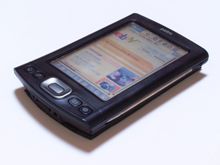|
SAIDE was recently commissioned by the Commonwealth of Learning
to look into the use of mobile technology for learner support in
open schooling in developing countries. Alice Barlow-Zambodla reports
on the findings from a desktop literature review.
Many developing countries are exploring Open Schooling models as
they strive to respond to the increased demand for secondary schooling
in the wake of rapidly expanding primary education. The suitability
of mobile technologies for learner support in Open Schooling systems
is part of this exploration. Mobile technologies in this instance
refer to wireless technologies such as hand-held Personal computers
(PCs), Personal Digital Assistants (PDAs), mobile phones and iPods
which are being punted as being suitable for the purpose of learner
support.
A variety of different mobile technologies are being tried out and
tested in innovative ways to support teaching and learning, both
inside a formal classroom and in the more informal arenas of learning.
Many online reports and articles give glowing reports of these initiatives
but there is very little more formally documented evidence of how
the use of these technologies is impacting on student performance.
This may be because many such initiatives are still in their initial
pilot phases, whilst others seem to have been carried out over too
short a period of time for there to be any measurable impact.
An initial desktop audit was carried out to determine what initiatives
are out there and to glean any documentary evidence of their impact
on student learning. This information was captured in the form of
a matrix (See
Attachment). The audit was carried out using the GOOGLE and
GOOGLE Scholar search engines.
Information collected varied considerably across different projects.
The following possible reasons are suggested:
- Projects are still in their infancy and there is not much information
about them.
- Some of the information is put out by corporate sponsors whose
emphasis is on disseminating information that focuses on advertising
their participation in corporate social investment initiatives.
- Other initiatives that were initially touted have probably
fallen from sight and were possibly once-off attempts.
The initiatives studied range from those that are institutionally-based
to those that are virtual in nature. However, the majority are located
in institutions.
Briefly the projects reviewed were:
- Most projects used mobile phones but others used other hand-held
devices such as e-slates and PDAs e.g. EduVision.
- Two of the initiatives (Digital Doorways and Hole in the Wall)
used ‘tethered technologies’ but were considered to
be useful for open schooling as these technologies were located
in rural areas and were openly available to those who wished to
use them whenever they wanted to.
- Five of the projects focus on High School students and in particular,
on the subject of mathematics e.g. Dr Maths on MXit and MLearner
Mobile.
- Mobile devices were used for other subjects like biology (MOOP
and MobilEd) and language ( MELFA and MobiDic), however, these
were in the minority.
- Some projects focussed on student administration and academic
support of mature distance education learners in tertiary institutions
e.g. The Makerere University MRSI, University of Pretoria and
the Dunia Moja Projects.
- BridgeIT covered literacy, numeracy, and basic science aimed
mainly at primary scholars.
- Two projects, SEMA and DEEP, were aimed at teacher development
and upgrading of teaching skills.
- The One World M4G project is a for profit project that focuses
on health education, jobs and lifestyle information and tips aimed
at low income earners in Kenya.
Funding arrangements
Most of the projects are not for profit. In some projects
parts of an offering are free, but there is a fee to get full functionality.
For example, full access to Mobi Maths requires the payment of a
monthly fee of R30. Most projects are made possible by and involve
Public Private Partnerships. A few projects like the MRSI and MLearner
Mobile are implemented and funded by a small group of private individuals
and receive little if any financial or other external support.
There were three different project funding arrangements:
- Donor or corporate-funded;
- Institution, itself, funds the project (self-funded);
- Not funded (individuals incur costs and time in their private
capacity.)
Purposes
Across the initiatives the following purposes were in evidence:
- Some of the systems are focussed on information retrieval and
download.
- Other systems make available information that is mediated either
for purposes of learning or passing on important administrative
information.
- In some projects mobile phones are used to collect information
and encourage cooperative learning and knowledge creation.
However, as can be seen by the gaps in the matrix after the desktop
exercise the desktop audit was not sufficient to generate the sort
of information that would enable one to make recommendations about
using mobile technologies for learner support.
The next phase of the project involved interviews and site visits
that would serve to generate more in-depth information. The outcomes
of these will be reported in the next newsletter.
| 
